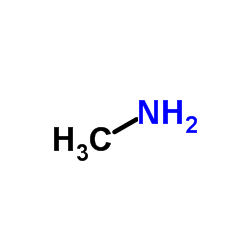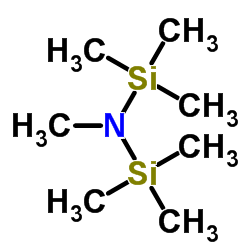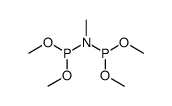17648-16-7
| Name | N,N-bis(dichlorophosphanyl)methanamine |
|---|---|
| Synonyms |
1,1,3,3-tetrachloro-2-methyl-diphosphazane
methylimidodiphosphorous tetrachloride Imidodiphosphorous tetrachloride,methyl methyl imidodiphosphorus tetrachloride |
| Boiling Point | 212.6ºC at 760 mmHg |
|---|---|
| Molecular Formula | CH3Cl4NP2 |
| Molecular Weight | 232.80100 |
| Flash Point | 82.4ºC |
| Exact Mass | 230.84900 |
| PSA | 30.42000 |
| LogP | 4.32720 |
| Vapour Pressure | 0.172mmHg at 25°C |
|
Section 1: Product Identification Chemical Name:Bis(dichlorophosphino)methylamine, min. 97% CAS Registry Number:17648-16-7 Formula:CH3Cl4NP2 EINECS Number:none Chemical Family:organophosphorus compound Synonym:none
Section 2: Composition and Information on Ingredients IngredientCAS NumberPercentACGIH (TWA)OSHA (PEL) Title compound17648-16-7100%no datano data Section 3: Hazards Identification Emergency Overview:Corrosive to skin, eyes and respiratory tract. Harmful by inhalation and if swallowed. Primary Routes of Exposure:Ingestion, inhalation, skin Eye Contact:Causes burns to the eyes. Skin Contact:Causes burns to the skin. Inhalation:Corrosive to the nose and mucous membranes. Inhalation may lead to headache and dizziness. Ingestion:Harmful if swallowed. Acute Health Affects:Corrosive to skin, eyes and respiratory tract. Harmful by inhalation and if swallowed. Chronic Health Affects:No information on long-term chronic effects. NTP:No IARC:No OSHA:No SECTION 4: First Aid Measures Immediately flush the eyes with copious amounts of water for at least 10-15 minutes. A victim may need Eye Exposure: assistance in keeping their eye lids open. Get immediate medical attention. Wash the affected area with water. Remove contaminated clothes if necessary. Seek medical assistance if Skin Exposure: irritation persists. Remove the victim to fresh air. Closely monitor the victim for signs of respiratory problems, such as difficulty Inhalation: in breathing, coughing, wheezing, or pain. In such cases seek immediate medical assistance. Seek medical attention immediately. Keep the victim calm. Give the victim water (only if conscious). Induce Ingestion: vomiting only if directed by medical personnel. SECTION 5: Fire Fighting Measures Flash Point:no data Autoignition Temperature:no data Explosion Limits:no data Extinguishing Medium:carbon dioxide, dry powder or foam If this product is involved in a fire, fire fighters should be equipped with a NIOSH approved positive pressure Special Fire Fighting Procedures: self-contained breathing apparatus and full protective clothing. Hazardous Combustion andIf involved in a fire this material may emit toxic and corrosive fumes. Decomposion Products: Unusual Fire or Explosion Hazards: No unususal fire or explosion hazards. SECTION 6: Accidental Release Measures Small spills can be mixed with vermiculite or other suitable absorbents. Spillage in areas not adequately Spill and Leak Procedures:ventilation will require an evacuation of site. Emergency response teams will require self-contained breathing apparatus. Spill should be absorbed into vermiculite or other suitable absorbent. SECTION 7: Handling and Storage Handling and Storage:Material must be handled and stored under an inert atmosphere of nitrogen or argon. SECTION 8: Exposure Controls and Personal Protection Eye Protection:Always wear approved safety glasses when handling a chemical substance in the laboratory. Skin Protection:Wear protective clothing and gloves. Ventilation:Handle the material in an efficient fume hood. If ventilation is not available a respirator should be worn. The use of respirators requires a Respirator Respirator: Protection Program to be in compliance with 29 CFR 1910.134. Ventilation:Handle the material in an efficient fume hood. Additional Protection:No additional protection required. SECTION 9: Physical and Chemical Properties Color and Form:colorless to pale yellow liquid Molecular Weight:232.80 Melting Point:no data Boiling Point:no data Vapor Pressure:no data Specific Gravity:no data Odor:pungent odor Solubility in Water:reacts with water SECTION 10: Stability and Reactivity Stability:moisture sensitive Hazardous Polymerization:no hazardous polymerization Conditions to Avoid:oxidizing agents, exposure to air and moisture Incompatibility:water, oxidizing agents, halogens, active metals carbon dioxide, carbon monoxide, organic fumes, hydrogen chloride, dimethylamine and phosphorus Decomposition Products: pentoxide. SECTION 11: Toxicological Information RTECS Data:No information available in the RTECS files. Carcinogenic Effects:No data Mutagenic Effects:No data Tetratogenic Effects:No data SECTION 12: Ecological Information Ecological Information:No information available SECTION 13: Disposal Considerations Disposal:Dispose of according to local, state and federal regulations. SECTION 14: Transportation Shipping Name (CFR):Corrosive liquids, N.O.S. Hazard Class (CFR):8 Additional Hazard Class (CFR):NA Packaging Group (CFR):II UN ID Number (CFR):UN# 1760 Shipping Name (IATA):Corrosive liquid, N.O.S. Hazard Class (IATA):8 Additional Hazard Class (IATA):NA Packaging Group (IATA):II UN ID Number (IATA):UN# 1760 SECTION 15: Regulatory Information TSCA:Not listed in the TSCA inventory SARA (Title 313):Title compound not listed Second Ingredient:none SECTION 16 - ADDITIONAL INFORMATION N/A |
| Precursor 2 | |
|---|---|
| DownStream 3 | |



![N,N-bis[bis(2,2,2-trifluoroethoxy)phosphanyl]methanamine structure](https://image.chemsrc.com/caspic/284/129672-91-9.png)

